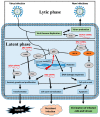Viral miRNAs as Active Players and Participants in Tumorigenesis
- PMID: 32033193
- PMCID: PMC7072176
- DOI: 10.3390/cancers12020358
Viral miRNAs as Active Players and Participants in Tumorigenesis
Abstract
The theory that viruses play a role in human cancers is now supported by scientific evidence. In fact, around 12% of human cancers, a leading cause of morbidity and mortality in some regions, are attributed to viral infections. However, the molecular mechanism remains complex to decipher. In recent decades, the uncovering of cellular miRNAs, with their invaluable potential as diagnostic and prognostic biomarkers, has increased the number of studies being conducted regarding human cancer diagnosis. Viruses develop clever mechanisms to succeed in the maintenance of the viral life cycle, and some viruses, especially herpesviruses, encode for miRNA, v-miRNAs. Through this viral miRNA, the viruses are able to manipulate cellular and viral gene expression, driving carcinogenesis and escaping the host innate or adaptive immune system. In this review, we have discussed the main viral miRNAs and virally influenced cellular pathways, and their capability to drive carcinogenesis.
Keywords: EBV; HBV; HCV; HHV-8; HPV; MCPyV; viral miRNAs.
Conflict of interest statement
The authors declare no conflict of interest.
Figures



References
Publication types
LinkOut - more resources
Full Text Sources

